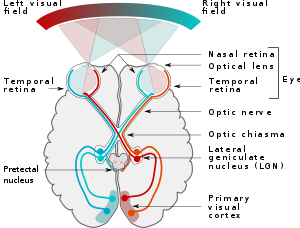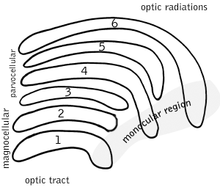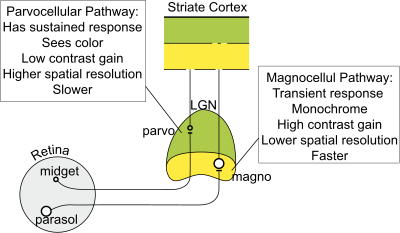User:Stromdabomb/subpage
Magnocellular Cells[edit]
Magnocellular cells, also called M-cells or magnocellular retinal cells, are neurons in the visual system. They are termed "magnocellular" due to their relatively large size. They project from parasol retinal ganglion cells in the eye to the lateral geniculate nucleus (LGN) of the thalamus, from which information is sent to areas of visual association cortex in the parietal and temporal lobes. They are one of three visual pathways leading from the retina to the LGN, distinct from the parvocellular pathway and the koniocellular pathway. M cells primarily collect information related to the location of objects in space and their motion.[1]
Cell structure[edit]
The magnocellular pathway begins in the retina of the eye, receiving input from parasol ganglion cells, which make up roughly 10% of all retinal ganglion cells.[1] These cells have large bodies[2][3] that have extensive, overlapping branched dendrites,[1][4] and thick, heavily myelinated axons. These properties allow magnocellular cells to conduct signals very quickly, much faster than parvocellular cells.[2][3]
Parasol ganglion cells collect information from large receptive fields,[1][3] containing both rods and cones.[5] Despite the input from cone photoreceptors, parasol ganglion cells do not receive information about color.[1][3] Unlike P cells, M cell receptive fields contain the same color-type of cones in both their center and surround regions. Due to this lack of specificity, M cells cannot differentiate between light wavelengths reflected from a specific object, and thus can only send achromatic information.[6]
There is approximately the same density of parasol ganglion cells in the fovea as in the rest of the retina, another property that distinguishes them from P cells.[4]
Magnocellular pathway[edit]


The parasol ganglion cells of the retina project via the optic nerve to the two most ventral layers of the lateral geniculate nucleus of the thalamus.[3] From here, the M pathway continues by sending information to the interblob regions of the 4Ca layer of the striate cortex.[1][7][8]
Some neurons send information directly from the striate cortex to the V5 region of the posterior parietal cortex,[9] but most project via optic radiations to either the thick or pale stripes of the extrastriate cortex.[7][8] The thick stripes of the extrastriate cortex project to the posterior parietal cortex as part of the dorsal stream, sending information to a variety of cortical regions including area V5,[7][10] which is highly interconnected with some frontal lobe regions.[11] M cell information sent to the pale stripes is sent to areas of the inferior temporal cortex, including area V4, as part of the ventral stream.[10]
Cell function[edit]
The magnocellular pathway cannot provide finely detailed or colored information,[2] but still provides useful static, depth, and motion information. The M pathway has high light/dark contrast detection,[12] and is more sensitive at low spatial frequencies than high spatial frequencies. Due to this contrast information, M cells are good at detecting changes in luminance, and are thus useful in performing visual search tasks and detecting edges.[13]
The M pathway is also important for providing information about the location of objects. M cells can detect the orientation and position of objects in space,[7][14] information that is sent through the dorsal stream.[15] This information is also useful for detecting the difference in positions of objects on the retina of each eye, an important tool in binocular depth perception.[7][16]
M cells have the ability to detect high temporal frequencies,[17] and can thus detect quick changes in the position of an object.[3] This is the basis for detecting motion.[7][12][18] The information sent to the Intraparietal Sulcus (IPS) of the posterior parietal cortex allows the M pathway to direct attention and guide saccadic eye movements to follow important moving objects in the visual field.[2][19][20] In addition to following objects with the eyes, the IPS sends information to parts of the frontal lobe that allows the hands and arms to adjust their movements to correctly grasp objects based on their size, position, and location.[15] This ability has led some neuroscientists to hypothesize that the purpose of the M pathway is not to detect spatial locations, but to guide actions related to the position and motion of objects.[21]
Some information has also been found to support the hypothesis that the M pathway is necessary for facial processing.[22]
History[edit]
Experimentation[edit]
While neurons are typically studied by the extracellular use of metal electrodes, retinal ganglion cells are specifically studied in vitro. This method allows M cells’ complicated and intertwined structure to be analyzed intracellularly. In 1941, Polyak was the first scientist to use Golgi staining to identify retinal ganglion cells. Here, dendritic morphology was closely analyzed and revealed large dendritic trees. Later in 1986, Kaplan and Shapely were then the first researchers to link M cells with the visual system. Recordings of S potentials at the axon terminals of RGCs in the LGN suggest that there is high contrast sensitivity in the cells terminating in the magnocellular layer of primates; opposed by low contrast sensitivity in cells found in the parvocellular layer.[1]
Primates[edit]
Both old and new world primates have been used as model systems for human vision and have subsequently been beneficial in researching M cells.[4] Many retrograde labeling experiments using macaques, for example, have linked parasol and midget retinal ganglion cells with magnocellular and parvocellular cells respectively. In addition, similar studies have led to theories underlying color opponency.[1][4] Research by Dacey (1996) supports this idea where in vitro primate retinal cells were treated with dye fillings. Parasol cells of the magnocellular pathway were found to be achromatic.[1] In other studies, new world monkeys, such as marmosets, have aided in the current understanding of spatial and temporal frequency of the magnocellular layer in the LGN. Using the Nissl staining method, the magnocellular layer, in addition to the parvocellular layer, have darker and more dense cell bodies than the koniocellular layers, for example.[19]
Retinal ganglion cells of cats have been studied and compared to those in the visual system of both primates and humans. Evidence on receptive fields of cats confirms that M cell receptive fields are larger than those of P cells because of their cellular structure. The same is likely to be found in human retinal cells which allows for better spatial localization.[1]
Magnocellular vs. parvocellular cells[edit]
While both magnocellular cells and parvocellular cells play an important role in the visual system, they differ slightly anatomically as well as in their functional contribution to vision.[1][19][23][24]
| M Cell | P Cell | |
|---|---|---|
| RGC Type | Parasol Cell | Midget Cell |
| Cell body size | Large | Small |
| Dendritic tree | Complex | Less complex |
| Conduction rate | ~1.6 ms | ~2 ms |
| Function in visual system | "Where" objects are; "How" to grasp the objects | "What" objects are according to fine detail |
| Sensitivity to spatial frequency | Low | Medium to high |
| Temporal frequency | High | Low |
| Color opponency | Achromatic | Red-green opponency |

Associated disorders[edit]
Abnormal magnocellular pathways of parasol cells can be associated with various disorders and ocular impairments, including dyslexia and schizophrenia.[2][22]
Dyslexia[edit]
Dyslexia is a disability which affects individual’s ability to read. It often first manifests in childhood, if at all. There is no clear idea of the role of M cells and the magnocellular pathway of parasol cells in dyslexia.
One theory suggests that the nonlinearity, size, and compensation of miniature eye movements of M cells all help to focus on a single target and blur the surroundings, which is crucial in reading. This suggests that M cells are underdeveloped in many dyslexics. This may be due to genetics, autoimmunity, or nutrition. M cells could vary in size and shape specifically from a mutation or variation in the KIAA0319 gene on chromosome six.[2] M cells are vulnerable to antineuronal antibodies which attack and render them unusable in the magnocellular pathway. This could be a cause of why dyslexics are more likely to have weakened immune systems.[2]
Schizophrenia[edit]
Schizophrenia is a mental disorder in which patients are unable to differentiate what is real and what is not. It is believed that the magnocellular pathway of parasol cells may help with facial recognition and discrimination in children, but when this pathway is not developed completely or correctly, facial processing is more difficult for individuals later in life. This is seen in patients with schizophrenia and occurs when there are issues in the integration of information from the M cell and P cell pathways, making it difficult for individuals with schizophrenia to differentiate between reality and hallucinations.[22]
References[edit]
- ^ a b c d e f g h i j k Callaway, Edward M (2005-07-01). "Structure and function of parallel pathways in the primate early visual system". The Journal of Physiology. 566 (Pt 1): 13–19. doi:10.1113/jphysiol.2005.088047. ISSN 0022-3751. PMC 1464718. PMID 15905213.
{{cite journal}}: CS1 maint: PMC format (link) - ^ a b c d e f g Stein, John (2014-01-01). "Dyslexia: the Role of Vision and Visual Attention". Current Developmental Disorders Reports. 1 (4): 267–280. doi:10.1007/s40474-014-0030-6. ISSN 2196-2987. PMC 4203994. PMID 25346883.
{{cite journal}}: CS1 maint: PMC format (link) - ^ a b c d e f Nassi, Jonathan J.; Callaway, Edward M. (2017-03-27). "Parallel Processing Strategies of the Primate Visual System". Nature reviews. Neuroscience. 10 (5): 360–372. doi:10.1038/nrn2619. ISSN 1471-003X. PMC 2771435. PMID 19352403.
{{cite journal}}: CS1 maint: PMC format (link) - ^ a b c d Lee, B. B. (1996-03-01). "Receptive field structure in the primate retina". Vision Research. 36 (5): 631–644. ISSN 0042-6989. PMID 8762295.
- ^ Hadjikhani, N.; Tootell, R. B. (2000-01-01). "Projection of rods and cones within human visual cortex". Human Brain Mapping. 9 (1): 55–63. ISSN 1065-9471. PMID 10643730.
- ^ Sincich, Lawrence C.; Horton, Jonathan C. (2005-01-01). "The circuitry of V1 and V2: integration of color, form, and motion". Annual Review of Neuroscience. 28: 303–326. doi:10.1146/annurev.neuro.28.061604.135731. ISSN 0147-006X. PMID 16022598.
- ^ a b c d e f Atkinson, J. (1992-01-01). "Early visual development: differential functioning of parvocellular and magnocellular pathways". Eye (London, England). 6 ( Pt 2): 129–135. doi:10.1038/eye.1992.28. ISSN 0950-222X. PMID 1624034.
- ^ a b Sincich, L. C.; Jocson, C. M.; Horton, J. C. (2010). "V1 interpatch projections to V2 thick stripes and pale stripes". Journal of Neuroscience. 30: 6963–6974.
- ^ McKeefry, D. J.; Watson, J. D.; Frackowiak, R. S.; Fong, K.; Zeki, S. (1997-01-01). "The activity in human areas V1/V2, V3, and V5 during the perception of coherent and incoherent motion". NeuroImage. 5 (1): 1–12. doi:10.1006/nimg.1996.0246. ISSN 1053-8119. PMID 9038280.
- ^ a b Yabuta, N. H.; Sawatari, A.; Callaway, E. M. (2001-04-13). "Two functional channels from primary visual cortex to dorsal visual cortical areas". Science (New York, N.Y.). 292 (5515): 297–300. doi:10.1126/science.1057916. ISSN 0036-8075. PMID 11303106.
- ^ Felleman, D. J.; Van Essen, D. C. (1991-01-01). "Distributed hierarchical processing in the primate cerebral cortex". Cerebral Cortex (New York, N.Y.: 1991). 1 (1): 1–47. ISSN 1047-3211. PMID 1822724.
- ^ a b Pokorny, Joel (2011-07-07). "Review: steady and pulsed pedestals, the how and why of post-receptoral pathway separation". Journal of Vision. 11 (5): 1–23. doi:10.1167/11.5.7. ISSN 1534-7362. PMID 21737512.
- ^ Cheng, Alicia; Eysel, Ulf T.; Vidyasagar, Trichur R. (2004-10-01). "The role of the magnocellular pathway in serial deployment of visual attention". The European Journal of Neuroscience. 20 (8): 2188–2192. doi:10.1111/j.1460-9568.2004.03675.x. ISSN 0953-816X. PMID 15450098.
- ^ Skottun, Bernt C.; Skoyles, John R. (2017-03-27). "On Identifying Magnocellular and Parvocellular Responses on the Basis of Contrast-Response Functions". Schizophrenia Bulletin. 37 (1): 23–26. doi:10.1093/schbul/sbq114. ISSN 0586-7614. PMC 3004196. PMID 20929967.
{{cite journal}}: CS1 maint: PMC format (link) - ^ a b Hebart, Martin N.; Hesselmann, Guido (2012-06-13). "What Visual Information Is Processed in the Human Dorsal Stream?". Journal of Neuroscience. 32 (24): 8107–8109. doi:10.1523/JNEUROSCI.1462-12.2012. ISSN 0270-6474. PMID 22699890.
- ^ Poggio, G. F.; Poggio, T. (1984). "The analysis of stereopsis". Annual Review of Neuroscience. 7: 379–412.
- ^ Anderson, Andrew J.; Jiao, Julie; Bui, Bang V. (2015-09-01). "Efficiently Measuring Magnocellular and Parvocellular Function in Human Clinical Studies". Translational Vision Science & Technology. 4 (5): 1. doi:10.1167/tvst.4.5.1. PMC 4559216. PMID 26346944.
{{cite journal}}: CS1 maint: PMC format (link) - ^ Vidyasagar, Trichur R. (2004-01-01). "Neural underpinnings of dyslexia as a disorder of visuo-spatial attention". Clinical & Experimental Optometry. 87 (1): 4–10. ISSN 0816-4622. PMID 14720113.
- ^ a b c Jayakumar, Jaikishan; Dreher, Bogdan; Vidyasagar, Trichur R. (2013-05-01). "Tracking blue cone signals in the primate brain". Clinical & Experimental Optometry. 96 (3): 259–266. doi:10.1111/j.1444-0938.2012.00819.x. ISSN 1444-0938. PMID 23186138.
- ^ Burr, D. C.; Morrone, M. C.; Ross, J. (1994-10-06). "Selective suppression of the magnocellular visual pathway during saccadic eye movements". Nature. 371 (6497): 511–513. doi:10.1038/371511a0. ISSN 0028-0836. PMID 7935763.
- ^ Goodale, M. A.; Westwood, D. A. (2004). "An evolving view of duplex vision: separate but interacting cortical pathways for perception and action". Current Opinion in Neurobiology. 14: 203–211.
- ^ a b c Bortolon, Catherine; Capdevielle, Delphine; Raffard, Stéphane (2015-06-01). "Face recognition in schizophrenia disorder: A comprehensive review of behavioral, neuroimaging and neurophysiological studies". Neuroscience and Biobehavioral Reviews. 53: 79–107. doi:10.1016/j.neubiorev.2015.03.006. ISSN 1873-7528. PMID 25800172.
- ^ Skottun, Bernt C. (2015-09-01). "On the use of spatial frequency to isolate contributions from the magnocellular and parvocellular systems and the dorsal and ventral cortical streams". Neuroscience and Biobehavioral Reviews. 56: 266–275. doi:10.1016/j.neubiorev.2015.07.002. ISSN 1873-7528. PMID 26188134.
- ^ Skoyles, John; Skottun, Bernt Christian (2004-01-01). "On the prevalence of magnocellular deficits in the visual system of non-dyslexic individuals". Brain and Language. 88 (1): 79–82. ISSN 0093-934X. PMID 14698733.
